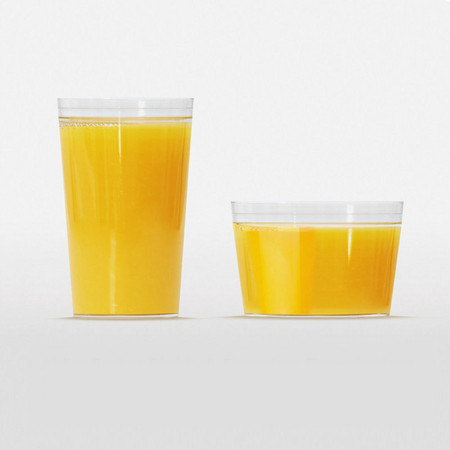Industrial designers have a responsibility. Especially when speaking of high quantities, even small sums could end up as considerable costs. For example, 10 g of unnecessary material in a serial production of 100,000 pieces adds up to a 1 t loss of material. This happens even though there are simple and effective ways to reduce material costs without threatening the longevity and stability.
Ideal Forms
Please imagine you have to design a can for a company that produces canned ravioli. This should have a determined volume, let’s say 0.5 litres. And according to conditions of production it has to have a cylindrical form. There are unlimited possibilities for how to realise that task. The can, for example, can be wide and flat or narrow and therefore very high.
All three cylindrical forms in the following graphics have the determined volume of 0.5 l. The Form in the middle has the smallest surface and therefore minimal material consumption. Compared to the other alternatives about 20 % less material is needed. Sure this might only be a few grams for a single can. But with a production volume of about 1 million ravioli cans a year this sums up to a couple of tons every year.
Naturally we cannot produce every product after that principle. The content is not always as flexible as ravioli. Nonetheless we can conclude:
For every geometrical form there exists an ideal ratio between surface and volume.
As the best possible constellation it minimises material use to reach a certain volume. This ideal ratio can be mathematically determined quite easily by calculating the extreme value. The best about this is: It can be adapted for nearly all products surrounding us, for example for those disposable cups handed out a million times every day in aeroplanes. The perfect form can reduce waste without letting passengers have less to drink.
On the contrary: The lower and wider form of the cup guarantees that the orange juice or cola lands in the stomach and not on the passenger’s lap. The ideal form is not only resource-efficient but – just as an added bonus – also almost tilt-proof.
And now imagine how big the saving potential could be with bigger products.
The graphic on the following page shows the ideal form for different geometric forms.
Of course the process to find the right form is far more complex than described below. To find the ideal form there are many other aspects to be considered like ergonomics or legal requirements. And many products are indeed far more complex than a can or a cup. Computers, MP3-players, and tumble dryers for example contain more components that have to be considered in design. To regard the principle of the ideal ratio with these products it is necessary to look at the essential and determined components first. What components cannot be varied in their dimensions? What are the minimal sizes? Are there any ergonomic aspects to consider? If these constants have been found a rough over-all form can be defined that fulfils the specific requirements and has approximately the ideal form with the lowest possible material costs. This should please producers and ecological activists likewise.


